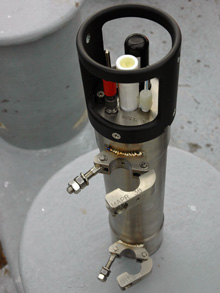
This Miniature Autonomous Plume Recorder (MAPR) is a self-contained instrument for recording temperature, pressure and optical data. 10 MAPR's are currently strung at various points on the wire above, and on a line below, the DSL120 clump weight, for the purpose of collecting data and detecting anomalies that may indicate the presence of hydrothermal plumes. Click image for larger view and image credit.
Lots of Heat, but How Many Hotsprings?
December 8, 2005
Ed Baker
Supervisory Oceanographer
How much hydrothermal activity occurs along the Galapagos Spreading Center (GSC)? Answering that question is my primary science goal for this cruise. It sounds like a routine, “postage stamp collecting” sort of mission, but the GSC is not a routine ridge. On most mid-ocean ridges, the amount of magma oozing up from the mantle is strictly governed by the rate at which the plates are separating. The faster plates spread apart, the more room there is for magma to form new ocean crust.
Just by chance, the GSC lies above an unusual mantle feature called a “hotspot.” Hotspots, like the one that has been creating the Hawaiian Islands for millions of years, are a long-lived source of extra magma to the seafloor. While the thickness of the Earth’s tectonic plates is close to 6 km almost everywhere, here at the GSC, directly over the hotspot the crustal thickness reaches almost 8 km. A simple prediction for the GSC might be: extra magma delivers extra heat to the ridge—throwing more logs on the fire—and thus more hydrothermal venting. The rate at which magma is delivered to a ridge is usually the single best predictor of the amount of hydrothermal activity found.But some geophysical models suggest a more complicated situation. The thicker, hotter crust might actually reduce venting. Perhaps because the crust is warmer than normal it can deform without breaking. Plastic-like deformation reduces the amount of cracking and restricts the flow of seawater that ultimately supplies the seafloor vents.
To test this theory we are towing a long instrument string through the waters above the seafloor. We have sensors to detect plumes by measuring the particle content and concentration of dissolved chemicals characteristic of hydrothermal discharge. Along the first 100 km of ridge the sensors deployed 100-120 m above the seafloor detected several plumes. Compared to other, similar expeditions using the same techniques along non-hotspot ridges, including faster-spreading ridges, this level of plume occurrence appears unusually low. However, we have yet to see the data from sensors deployed at other depths, therefore we do not yet know how many plumes we have passed through.

Data streamed in real-time from sensors on board the DSL120 are displayed on a monitor in the control van. Among the measurements displayed are changes in redox (electrical) potential of the surrounding seawater. The redox potential (Eh) of waters sampled by sensors on the DSL120 often drops when the sensor passes through a hydrothermal plume. A drop in the Eh, like you see here, means that there are more free electrons in the water produced by enrichment of seawater in dissolved metals and chemicals billowing out of hydrothermal vents. Click image for larger view and image credit.
Hence, we are careful not to rush to conclusions. We have been exploring less than a week, and have a month of work still to be done. And we have not even visited the portion of the GSC where the hotspot is centered. On other expeditions we have mapped ridge sections where long tows find the ridge barren of activity, only to be followed by ridge lengths crowded with billowing plumes. Even 100 km of ridge is too short to give a true picture of the hydrothermal character of the GSC, since vents are never uniformly arranged along the seafloor.
Ocean exploration almost always uncovers surprises, and many more await us as we methodically map the seafloor and deep waters along one of Earth’s most interesting mid-ocean ridges.
Fast Fact
Did you know that hydrothermal vents on the deep mid ocean ridge of the Galapagos Spreading Centerwhere first discovered in 1977?
Sign up for the Ocean Explorer E-mail Update List.




























